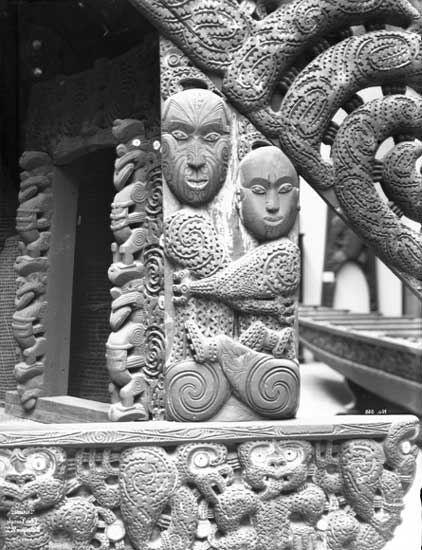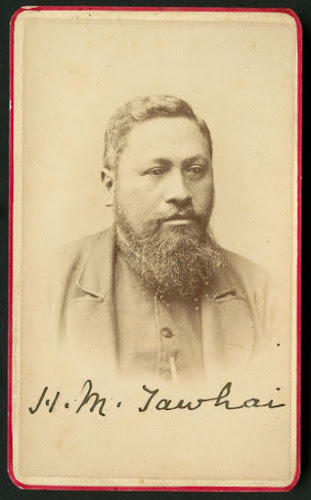Indigenous Agency versus Enforced Assimilation: The Role of Maori Committees in the Nineteenth Century
Satirical analyses of New
Zealand culture and society have often poked fun at the fondness of New
Zealanders for forming and joining committees. As Austin Mitchell wrote in
1972, ‘[g]ive them a problem and they’ll set up a committee’. And although it
is rarely mentioned in such contexts, Maori were early and fervent converts to
this apparent national trait. Their problem was a big one: how to find a place
for themselves in the colonial era following the signing of the Treaty of
Waitangi in 1840 that did not involve being entirely subsumed by this new
order. At stake was the very survival of Maori society itself.
Over the years I have written
extensively on the history of Maori komiti (committees), and related runanga
(tribal councils), exploring the legacy of efforts on the part of nineteenth-century
Maori to establish new institutions of self-government in the colonial context.
My first book Agents of Autonomy: Maori Committees in the Nineteenth Century, published by Huia in 1998, was on
this topic. Some six years later I completed a doctoral thesis on the same subject,
followed by articles in the Journal
of the Polynesian Society, Ethnohistory
and elsewhere, along with another book (co-authored with David Armstrong)
that featured the various tribal komiti of Te Arawa extensively (The Beating Heart). For the purposes of
the present discussion I have adapted the introduction to my thesis (sans lengthy
footnotes and some extraneous material), in order to provide an overview of some of my main arguments on
this topic.
A primary focus of my work
with respect to komiti and runanga has concerned the nature of Crown responses
to these, ranging from periodic efforts at co-opting officially recognised but
grossly weakened komiti and runanga into the framework of machinery governing
Maori, to studied indifference, and, at the other extreme, occasional outright
persecution of such institutions. On the other side of the coin, I argue that the
runanga and komiti of the nineteenth century were a remarkable response to
colonisation on the part of those Maori men and women who formed them and that the
importance of these institutions of self-government in the post-contact history
of Maori society can scarcely be exaggerated.
Such a conclusion is not
premised on romanticised notions of Maori ‘resistance’ to colonisation. Indeed,
regardless of the broader historiographical merit or otherwise of such labels,
notions of ‘resistance’ versus ‘collaboration’ strategies have little currency
in the context of a study in which komiti-style mechanisms of self-government
were utilised by nearly all Maori communities, be they supposedly ‘loyalist’ or
‘rebel’ in inclination and outlook, in pursuit of the overriding objective of
cultural and political survival. Put simply, runanga and komiti provided a
mechanism for the preservation of intra-group cohesion, and a model for
inter-group unity, at a time when Maori society was under severe danger of
succumbing to the threat posed to its very existence by the new colonial order.
At one level the nature of
this threat was very simple: Crown politicians and officials saw no place for
Maori customs and institutions within the newly-British colony. Assimilation
remained the bedrock ideology underpinning all Crown policy with respect to
Maori in the nineteenth century. From this perspective it was axiomatic that
runanga and komiti had no future. In its purest conception, then, such a dogma
could have only one possible policy outcome: active suppression of such
institutions. Yet for pragmatic Crown officials, concerned with maintaining
order, such an approach, as a general policy, remained potentially disastrous
right up until the 1870s, and risky thereafter. Maori were simply too strong,
militarily and demographically (despite a population base which was in decline
through until the 1890s) to make active suppression a realistic option, except
in a targeted or selective way.
Given the spontaneous
developments within Maori society over much of the nineteenth century to
establish or revive stronger institutions of self-government, and the inherent
risks involved in trying to suppress these, two further policy avenues remained
open to Crown officials. The first of these, ignoring the runanga and komiti,
was much less risky in the short term, but on the face of it did little to
advance the assimilationist agenda. It was also not without its own dangers
over time. Gains made in extending substantive British sovereignty into
formerly Maori-controlled districts could be jeopardised by robust runanga and
komiti acting as a counter to the diminution of Maori autonomy. Left unchecked,
such institutions could simply become too powerful for the Crown to ignore.
Co-option of unofficial
runanga and komiti, or rather of the Maori aspiration to have legalised
institutions recognised by the Crown, therefore remained a viable alternative.
If such bodies were going to be established regardless of whether they received
official endorsement, it was better by far, so this argument went, to have
these under the control and direction of the Crown than outside of it. Active
but unofficial runanga and komiti were an unpredictable and unmanageable
element. Co-opted institutions, on the other hand, were not intended as
mechanisms of self-government, but rather of indirect rule. They could, in
fact, be utilised to further the assimilationist aims and serve as an
instrument of the Crown rather than a threat to it. Yet this, too, was a risky
strategy. Critics feared that, having achieved Crown recognition, Maori communities
would employ such bodies to further their own ends, rather than those of the
Crown. The risk lay in the possibility that Maori might reappropriate the
intended mechanisms of co-option in altogether unexpected, or rather unwanted,
ways.
Thus while the assimilationist
ideology remained straightforward, and was widely-shared by Crown
representatives and ordinary settlers alike, its policy implications were
keenly contested. Targeted suppression, containment and co-option, and studied
disregard, each had their supporters as preferred policy and were reflected in
the actions of different officials and politicians over time. Prior to the
1860s (and in some areas thereafter) Britain’s paper sovereignty over New
Zealand, and the desire of Crown officials to assert the primacy of British
institutions and enforce the rule of law throughout the country, competed with
the reality that substantial parts of the North Island remained under Maori
control. The establishment of a highly formal, and Pakeha-controlled, Native
Land Court in 1865 (a product of increased settler hegemony, and Pakeha
demographic dominance, in the wake of the Waikato War of 1863–1864) constituted
a new and significant threat to Maori society.
Proponents of this new court
envisaged it not simply facilitating the direct purchase by settlers of large
areas of Maori land, but through individualising land titles and severing the
bonds between rangatira and their people, also furthering the assimilationist
agenda. Some Crown officials supported a role for komiti and runanga in
undertaking preliminary investigations of land titles, thereby essentially
facilitating the work of the Native Land Court. Others worried that such
institutions would act as a barrier to both the alienation of lands and to the
court’s role as an agent of assimilation. It was precisely because the Native
Land Court was perceived as such a successful mechanism of alienation and
assimilation that many Crown officials feared taking any steps to legally
recognise runanga and komiti. Left unaided, through a policy of deliberate
indifference, such institutions might die a natural death, hastened in no small
way by the work of the Native Land Court. From a Crown perspective, there were
good arguments on both sides of the debate, however, and the policy outcomes
were again subject to fluctuation.
Maori communities were fully
aware of the threat posed by the Native Land Court, both in terms of the havoc
it had the potential to cause to their social organisation and the substantial reduction
in their landed base it promised to bring about. It was largely, though not
solely, with these threats in mind that the 1870s witnessed a major revival and
reinvention of komiti to act as a counter to the Native Land Court, just as the
1850s had earlier seen runanga undergo a similar transformation when confronted
for the first time with the General Assembly and settler government. Revamped
runanga and reappropriated komiti remained at the forefront of Maori efforts in
the nineteenth century to establish a relationship with the Crown posited on
partnership, rather than on acceptance of the primacy of Pakeha institutions
and ideas.
These mechanisms of
self-government were not, as many settlers at the time believed, a mere
imitation of Pakeha institutions, but nor were they simply a reversion to
‘traditional’ structures, however these might be defined. Instead, the runanga
and komiti of the post-Waitangi era had distinctly bicultural pedigrees to
them, even whilst being employed in pursuit of identifiably Maori aspirations.
Runanga and komiti began as culturally distinct institutions, the former of
Maori origins and the latter a missionary-imported mechanism of social control,
later reappropriated by Maori to serve new ends. In blending indigenous and
exotic influences runanga and komiti became, by the later nineteenth century,
more or less indistinguishable from one another. Distinct new institutions of
self-government which remained identifiably Maori, yet with other cultural
roots as well, had been developed. This was not tacit deference to a superior
civilisation, or acceptance of the assimilationist agenda. It was rather
evidence of a spirited and resilient society responding to the challenges which
confronted it with the best means available. All successful cultures throughout
human history have had the capacity to absorb new technologies, resources and
ideas from other societies and to adopt and adapt these in ways that aligned
with their own priorities. Maori in the nineteenth century were no exception to
this rule.
The runanga and komiti which
Maori established, reformed, reviewed, co-opted, adopted, adapted and
appropriated were indeed, therefore, ‘agents of autonomy’. Yet they were not
free agents. As David Chappell has warned, an historiography of indigenous
peoples that privileges agency in a well-intentioned backlash against earlier
‘fatal impact’ histories, can, if given paradigmatic status, perpetuate
colonial narratives in a new garb. Victims need not be passive, and agents are
rarely free from constraints that limit their range of potential actions.
Agents and victims are not, as Chappell noted, ‘mutually exclusive categories
but contextually signified roles’. This seemingly simple truth is also a highly
pertinent one to keep in mind when considering the history of runanga and
komiti in the nineteenth century.



Comments
Post a Comment